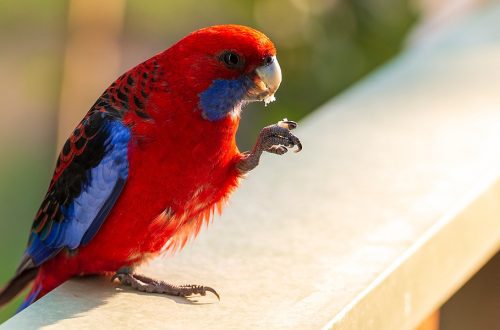
Green-winged Macaw (Ara chloropterus)

| Order | Psittaci, Psittaciformes = Parrots, parrots |
| family | Psittacidae = Parrots, parrots |
| Subfamily | Psittacinae = True parrots |
| Race | Ara = Ares |
| View | Ara chloropterus = Green-winged macaw |
Green-winged macaws are an endangered species. They are listed in the CITES Convention, Appendix II
Contents
APPEARANCE
Macaws have a length of 78 – 90 cm, weight – 950 – 1700 gr. Tail length: 31 – 47 cm. They have a bright, beautiful color. The main color is dark red, and the wings are blue-green. Cheeks are white, not feathered. The naked face is decorated with small red feathers, which are arranged in several rows. The rump and tail are blue. The mandible is straw-colored, the tip is black, the mandible is sulphurous black.
Feeding
60 – 70% of the diet should be grain seeds. You can give walnuts or peanuts. Green-winged macaws are very fond of jagoras, fruits or vegetables. It can be bananas, pears, apples, raspberries, blueberries, mountain ash, peaches, cherries, persimmons. Citrus fruits are given only sweet, in small pieces and limitedly. All of these are given in limited quantities. Gradually give crackers, fresh Chinese cabbage, porridge, hard-boiled eggs and dandelion leaves. Suitable vegetables: cucumbers and carrots. Give fresh branches of fruit trees, thick or small, as often as possible. They contain essential vitamins and minerals. The water is changed daily. Green-winged macaws are food conservatives. However, despite this, it is worth adding variety to the diet as much as possible. Adult birds are fed twice a day.
Breeding
To breed green-winged macaws, a number of conditions must be created. These birds do not breed in cages. Therefore, they need to be kept in an aviary all year round, and separately from other feathered pets. The minimum size of the enclosure: 1,9×1,6×2,9 m. The wooden floor is covered with sand, sod is laid on top. A barrel (120 liters) is fixed horizontally, at the end of which a square hole 17×17 cm is cut. Sawdust and wood shavings serve as nesting litter. Maintain a stable air temperature (about 70 degrees) and humidity (about 50%) in the room. 50 hours of light and 15 hours of darkness.





